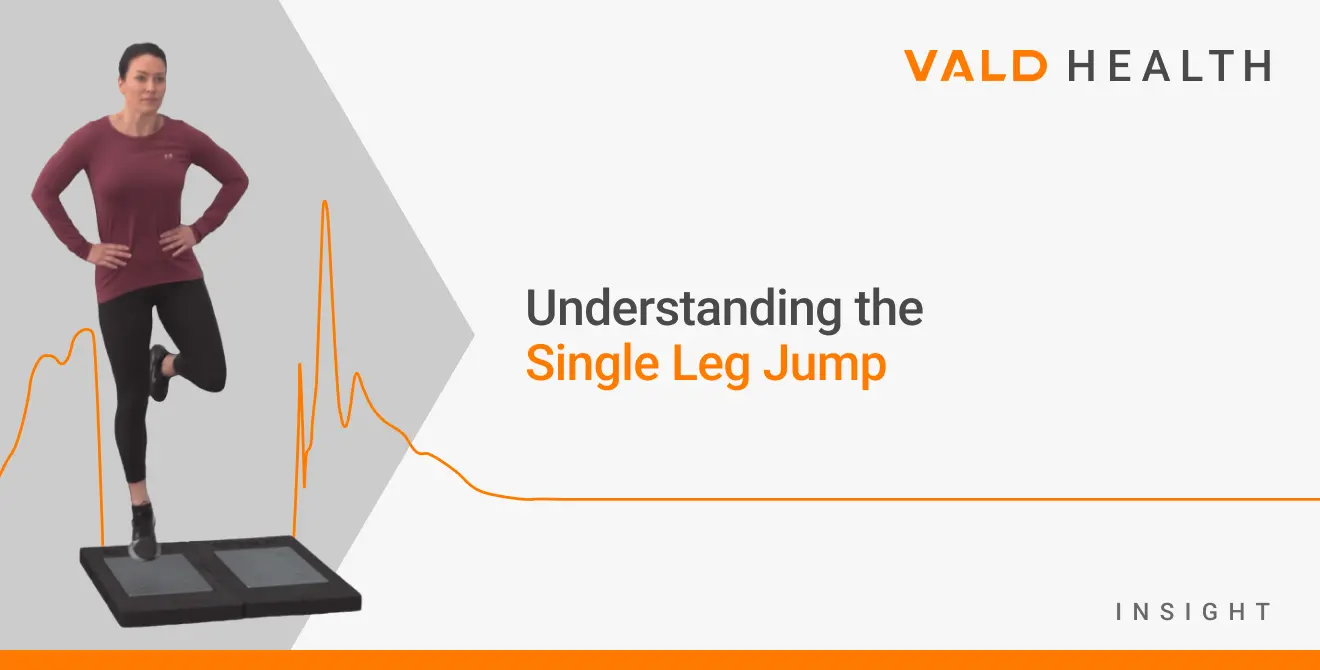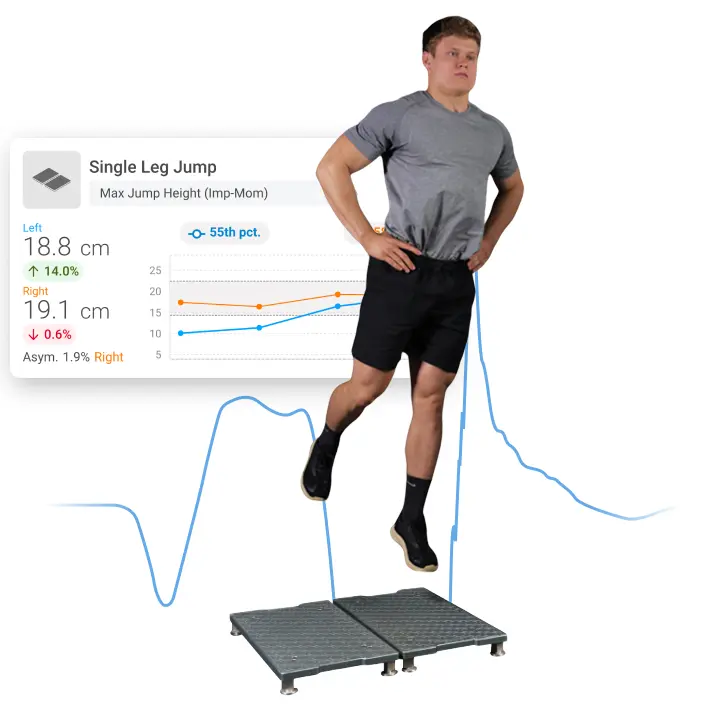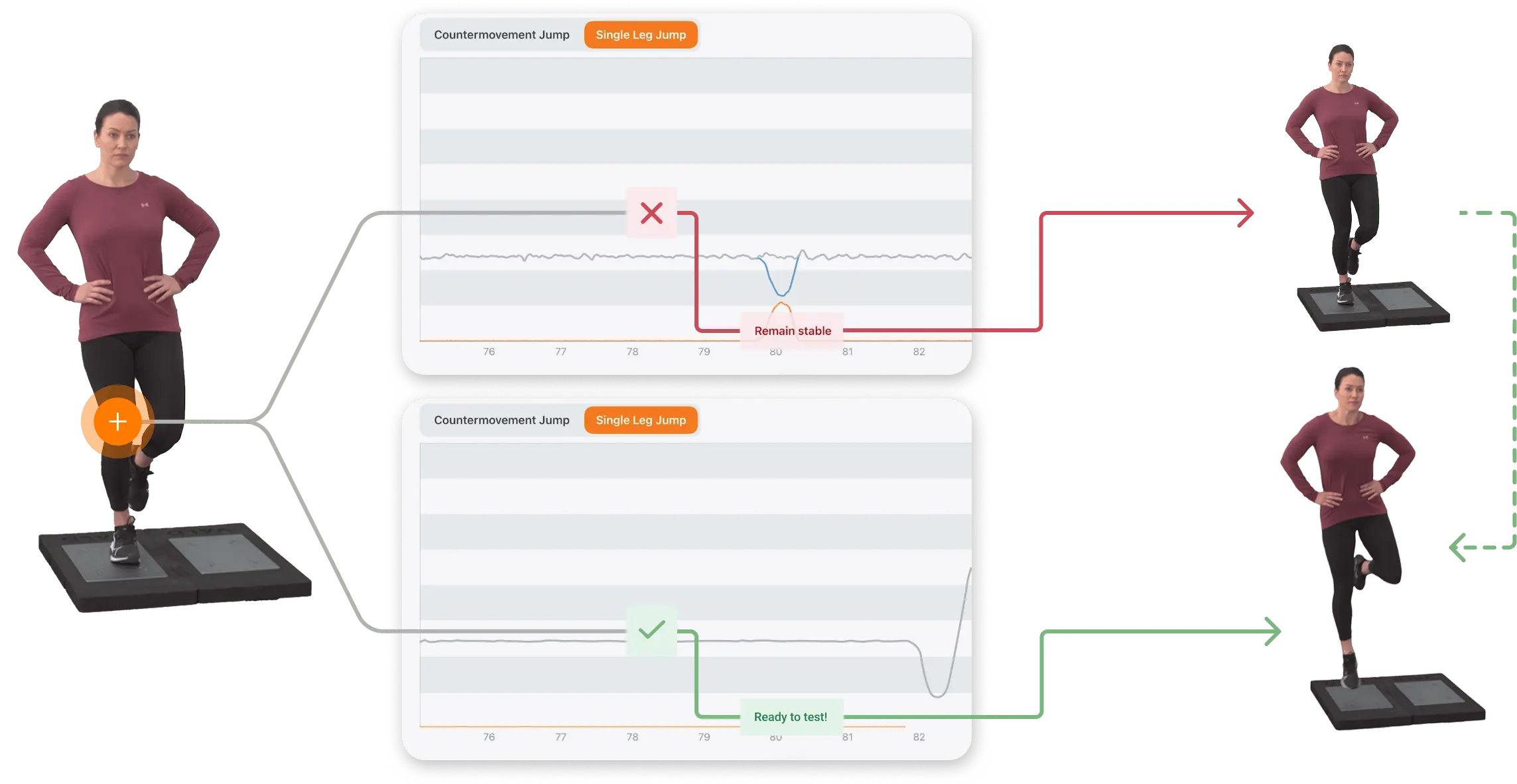Understanding the Single Leg Jump
Available in:
EN
The single leg jump (SLJ) assessment is a staple in performance and rehabilitation, offering practitioners insights into unilateral power and dynamic movement strategies. Unlike bilateral jumps, the SLJ isolates each limb, challenging stability, capacity and control with maximal effort to reveal inter-limb differences that may remain hidden in double-leg assessments (Maestroni et al., 2023; Maloney et al., 2015).
This article explores the SLJ protocol, the utility of the assessment, key force plate metrics, considerations for practitioners and how this test informs decision-making across performance enhancement and rehabilitation.
What Is the SLJ?
The SLJ is a unilateral vertical jump performed with a countermovement, aiming to jump as high as possible while maintaining balance and control throughout all phases. Unlike a single leg drop jump (which incorporates a pre-landing drop phase), the SLJ begins from a static single leg stance on a force plate.

Athlete performing a left-sided SLJ with VALD Hub report tile.
[The SLJ assesses] an individual’s single leg power, stability and jump strategy…key components in [running, jumping, change of direction and single leg tasks].
The purpose of the SLJ is to assess an individual’s single leg power, stability and jump strategy between limbs as these are key components required in most field and court sports. These characteristics can serve as proxy measures for an athlete’s horizontal and vertical force management capabilities (Kotsifaki et al., 2022).
Protocol Overview
ForceDecks analyzes SLJ performance through key phases of movement.
| Phase | Description | Key Instructions |
| Setup (Start of Movement) | Athlete stands still on one leg in the center of ForceDecks; system weight reaches a stable, flat line before test execution |
Maintain balance with minimal force fluctuation prior to movement initiation, then instruct the contralateral leg to be lifted to thigh-parallel (hip and knee at 90°) or actively extended beyond neutral, and held in this position throughout the entire movement
|
| Unweighting | Downward movement involving triple flexion at the hip, knee and ankle; ends at the minimum force point | Control descent with minimal forward trunk lean; avoid excessive depth beyond the typical athletic range |
| Braking Phase | Portion of eccentric phase where force rises from minimum force to eccentric peak velocity | Maintain upright alignment during triple flexion to maximize efficient use of lower extremity stretch-shortening cycle (SSC) (i.e., patellar and Achilles tendons) |
| Deceleration Phase | Portion of eccentric force from eccentric peak velocity to zero velocity | |
| Zero Velocity | The amortization period is the transition between eccentric and concentric phases, where velocity is zero | Ensure a stable reversal point without excessive time |
| Concentric Phase | Upward movement from end of eccentric phase to takeoff | Emphasize explosive triple extension through the ankle, knee and hip to maximize jump height |
| Flight Phase | From takeoff (force drops below threshold, typically 20N) to landing (force exceeds 20N again) | Maintain a controlled posture and minimal unnecessary limb movements |
| Landing Phase (Impact Phase) | From initial contact to stabilization post-landing | Absorb impact with control |
…SLJ metrics are more reliable when averaged across multiple trials. Consistent cueing and execution are integral to accurate SLJ data collection.
As with most assessments and data collection strategies, SLJ metrics are more reliable when averaged across multiple trials (e.g., three attempts). Consistent cueing and execution are integral to accurate SLJ data collection.
Key Metrics for SLJ
ForceDecks provides a comprehensive analysis of the SLJ with over 100 metrics to assess unilateral lower-body power. Practitioners working in a particular discipline, such as healthcare or performance training, may focus on different metrics.

Characteristics of a well-executed SLJ.
Practitioners who focus on athlete performance training, such as strength and conditioning coaches or performance staff members, may focus on metrics geared towards monitoring higher-level outputs and detecting changes in fatigue that influence performance. Some of these metrics may include:
| Metric | Definition (VALD Glossary) | Insights and Application |
| Jump Height* | Maximum displacement of the center of mass between takeoff and landing | Represents unilateral explosive power capacity; higher values indicate greater concentric force production and movement efficiency |
| Eccentric Peak Force | Maximum vertical force recorded in the eccentric phase | Demonstrates ability to dissipate eccentric loads and control rapid movement; relevant for deceleration and jump performance |
| Eccentric Deceleration RFD | RFD over the full eccentric deceleration phase | Measures rapid force attenuation capabilities; important for injury prevention and change of direction ability |
| Reactive Strength Index-Modified (RSI-Mod) | Jump height divided by contraction time | Serves as a proxy measure of explosiveness and movement efficiency in jumps |
* Calculated using three methods: impulse momentum, flight time and impulse displacement.
Practitioners focused on health and rehabilitation – such as physical therapists, athletic trainers or medical doctors – may prioritize a different set of SLJ metrics. Their emphasis often lies in restoring key capacities and movement strategies while ensuring performance benchmarks are met to support a safe and timely transition to performance staff.
| Metric | Definition (VALD Glossary) | Insights and Application |
| Peak Landing Force Asymmetry | Percentage difference in maximum vertical force after landing between two limbs | Highlights inter-limb discrepancies in landing strategy or capacity; can inform return-to-play decisions |
| Concentric Peak Force | Highest force produced during the concentric phase | Reflects maximal strength expression of the limb in a rapid task; useful in identifying force production capabilities between sides |
| P2 Impulse | Net impulse during the second 50% of the concentric phase (time-dependent) | Indicates overall force application capacity; sensitive to jump performance within long-term rehabilitation |
| Contraction Time | Time from start of movement to takeoff | Shorter times may indicate efficient SSC utilization; context dependent based on technique and strategy |
Practitioners who work in return-to-play and high-performance rehabilitation can learn more about the SLJ in the Practitioner’s Guide to ACL.
These data points – especially when considered within the broader context of an athlete’s assessment profile – can help identify their current stage in rehabilitation or their present athletic capabilities.
Key Physical Qualities Required for the SLJ
Performing an SLJ safely and effectively requires:
The SLJ mirrors the same physical demands athletes face during sport – explosive power, postural stability, neuromuscular control and the ability to absorb and redirect force. These traits are critical for high-speed movements experienced in sports such as football, basketball, tennis and soccer.
The SLJ mirrors the same physical demands athletes face during sport…deficits in any physical quality flag practitioners to dive deeper…
Deficits in any physical quality flag practitioners to dive deeper and reassess their current training program to improve trainable qualities.
Benefits of the SLJ Assessment
The SLJ helps identify key asymmetries that may signal poor movement strategies, altered injury status or limitations influencing rehabilitation progress. Specifically, many practitioners turn to the SLJ for four key characteristics:
Testing Considerations
The SLJ is valuable in both rehabilitation and performance settings, but athletes should first meet strength, plyometric or rehabilitation benchmarks to ensure readiness. Once appropriate capacities are established, practitioners can apply key testing considerations to extract high-quality insights from the assessment.
| Consideration | Application |
| Standardization | Maintain consistent footwear, instructions and testing environment for repeatability |
| Familiarization | Allow practice trials to reduce learning effects and ensure maximal effort validity |
| Technique Focus | Emphasize controlled descent and powerful extension while avoiding knee valgus or trunk lateral shift |
| Data Interpretation | Combine force metrics with visual analysis to contextualize results within technical execution quality |
| Integration with Rehabilitation Stages | Use as a progression post-bilateral jumping to assess single limb tolerance to plyometric load |
Fatigue level at the time of testing is an important consideration. Some practitioners use the SLJ to monitor fatigue response – testing after competition or intense training to evaluate how fatigue impacts performance.
Some practitioners use the SLJ to monitor fatigue response…[but] when the goal is to monitor adaptations…consistency in test timing is critical.
However, when the goal is to monitor training adaptations over time, consistency in test timing is critical. In these cases, assessments like the SLJ and isometric tests are typically performed after movement prep or warm-up to ensure maximal effort and reliable comparisons across sessions.
Different methods of monitoring performance, fatigue and overall health with the SLJ.
Common Faults in the SLJ
As a dynamic task, execution errors may influence data quality. Most often, data reliability and test consistency are influenced by two main factors:
- Contralateral leg swing
- Single leg dynamic balance
The SLJ is designed to assess constrained unilateral power. While a contralateral leg drive may lead to greater jump performance, it can also mask deficits through compensation – similar to how an arm-swing can obscure limitations in a CMJ.
…a contralateral leg drive [in the SLJ] may lead to greater jump performance, [but] it can also mask deficits through compensation…
To reduce these compensations and gain a more accurate measure of unilateral power, practitioners can constrain the non-jumping leg (e.g., instructing the athlete to lift their knee to parallel throughout the test).

Common faults and subsequent results of poor countermovement jump (CMJ) execution.
Single leg dynamic balance limitations often lead to unsteady quiet and landing phases. Similar to other familiarization strategies seen in isometrics, practitioners can screen SLJ balance capacities through incorporating SLJs into athlete training schedules 1-4 weeks prior to testing to ensure adequate familiarization.
New features in ForceDecks – like the automatic stability indicator – assist practitioners in gathering high-quality data, especially when measuring qualities that are more sensitive to start of movement detection, such as RFD.
Practitioners should set athlete expectations before testing to remain as still as possible before the jump. The stable indicator is sensitive to even small fluctuations in force output, ensuring that start of movement detection is as accurate as possible.

ForceDecks’ recent update includes a stable indicator to ensure quiet phase is sufficiently stable for optimal start of movement detection.
Takeaways
The SLJ offers insight into an athlete’s unilateral explosive power, stability and movement strategies – critical factors for both performance optimization and safe return-to-play decisions.
With tools like ForceDecks, practitioners can capture reliable, objective data to assess capabilities, monitor progress over time and individualize training or rehabilitation based on specific needs. From identifying residual deficits post-injury to enhancing unilateral power outputs, the SLJ remains a key assessment that connects scientific measurement with practical outcomes in sport and health.
Get in touch with our team to learn how ForceDecks and other VALD systems can support your assessment, rehabilitation and performance needs.
References
- Maestroni, L., Turner, A., Papadopoulos, K., Cohen, D., Sideris, V., Graham-Smith, P., & Read, P. (2023). Comparison of strength and power characteristics before ACL rupture and at the end of rehabilitation before return to sport in professional soccer players. Sports Health, 15(6), 814–823. https://doi.org/10.1177/19417381231171566
- Maloney, S. J., Fletcher, I. M., & Richards, J. (2015). A comparison of methods to determine bilateral asymmetries in vertical leg stiffness. Journal of Sports Sciences, 34(9), 829–835. https://doi.org/10.1080/02640414.2015.1075055
- Kotsifaki, A., Van Rossom, S., Whiteley, R., Korakakis, V., Bahr, R., Sideris, V., & Jonkers, I. (2022). Single leg vertical jump performance identifies knee function deficits at return to sport after ACL reconstruction in male athletes. British Journal of Sports Medicine, 56(9), 490–498. https://doi.org/10.1136/bjsports-2021-104692
